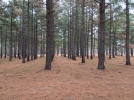| |
Hello Visitor,
Welcome to the Fall 2019 version of the Temperate Agroforester. The newsletter welcomes contributions for future issues and input or feedback about anything that you read in this issue.
Christine Nieman, Steve Gabriel, Callie Maron, and Jennifer Ghigiarelli Editors - Temperate Agroforester
Events
Call to Action
AFTA needs you! We need your research updates, blog posts, news items and other information to inform our followers. Contact: Andres Anchondo. We are also looking for volunteers to help with membership engagement and website content. Volunteer today to help keep AFTA moving foward.
Membership
Are you a member of AFTA? If not consider joining by clicking here. Your membership gives you access to the members-only area, discounts on conference registration, and helps support AFTA's mission to promote agroforestry.
Contents
Christine Nieman and Dirk Philipp. USDA ARS Dale Bumpers Small Farms Research Center, Booneville Arkansas. University of Arkansas, Animal Science Department, Fayetteville, Arkansas.
 Researchers at the University of Arkansas and USDA ARS Dale Bumpers Small Farms Research Center (DBSFRC) are investigating forage establishment and persistence in loblolly pine plantations in Arkansas. There has been an increased interest in silvopastoral systems in Arkansas due to incentives related of diversified production as well as creating wildlife habitat and additional hunting and grazing land. Many small beef producers have attempted to establish silvopastures, but have failed to maintain forage for grazing, discouraging further pursuit (Huff, J., personal communication).
Read More
Leonard C. Kibet, Girish Panicker, Jacqueline Mccomb, Gwendolyn Boyd, Lashunda A. Hodges, Avis Joseph and Frank Mrema. School of Agriculture and Applied Sciences, Alcorn State University, Lorman, MS 39096
 Agroforestry practices have the potential of enhancing food production and environmental quality particularly in the era of climate change. According to USDA Forest Service statistics (Oswalt, et al., 2017), approximately 61% of Mississippi land is forested, hence the state offers a unique opportunity to study how agroforestry systems can improve food production and environmental quality. Notably, South west Mississippi is home to many small-scale limited resources farming communities and this experiment will provide new insights about the potential food production and environmental quality benefits of horticultural based agroforestry. For producers with limited resources, diversification of agricultural practices is key to improving sustainability of farm resources. Indeed, diversification has been acknowledged for its role in enhancing sustainable growth compared to monocrop production system in the rural sector (Barghouti, et al., 2004)
Read More
Jacob Grace, Savanna Institute
 Wisconsin’s first public agroforestry demonstration site was established in the summer of 2019 at Silverwood County Park in south-central Wisconsin (Figure 1). The 18-acre demonstration site features alley cropping, a variety of fruit and nut trees and shrubs, and a Tasting Orchard. This agroforestry demonstration farm will serve as a hands-on educational center for the park’s existing K-12 education program, adult workshops and classes, and for all park visitors through interpretive signs positioned around the site, as well as a training site for beginning agroforestry farmers.
Read More
Amanda M. Foust - School of Forestry and Natural Resources, University of Arkansas at Monticello, Monticello, AR, USA; Arkansas Forest Resource Center, University of Arkansas System Division of Agriculture, Monticello, AR, USA
 Shade for livestock has been cited as one of the top reasons for establishing silvopastures (Orefice et al. 2017). One of the many benefits of shade for cattle production is that access to shade has been shown to limit the amount of time cattle spend congregated around their water troughs (Schütz et al. 2010). Minimizing the time cattle spend congregated around water troughs can reduce soil compaction around the water trough, decrease damage to watering equipment, and mitigate wasting water. While this concept has been demonstrated using artificial shade structures, there is currently limited information about the benefits of natural tree shade for limiting cattle congregation behavior around water resources. As cattle typically prefer natural tree shade to artificial shade structures (Zuo and Miller-Goodman 2004), silvopastures may combine the benefits of shade with various additional ecological benefits such as enhancing wildlife habitat, soil conservation, and water quality.
Read More
|
|




